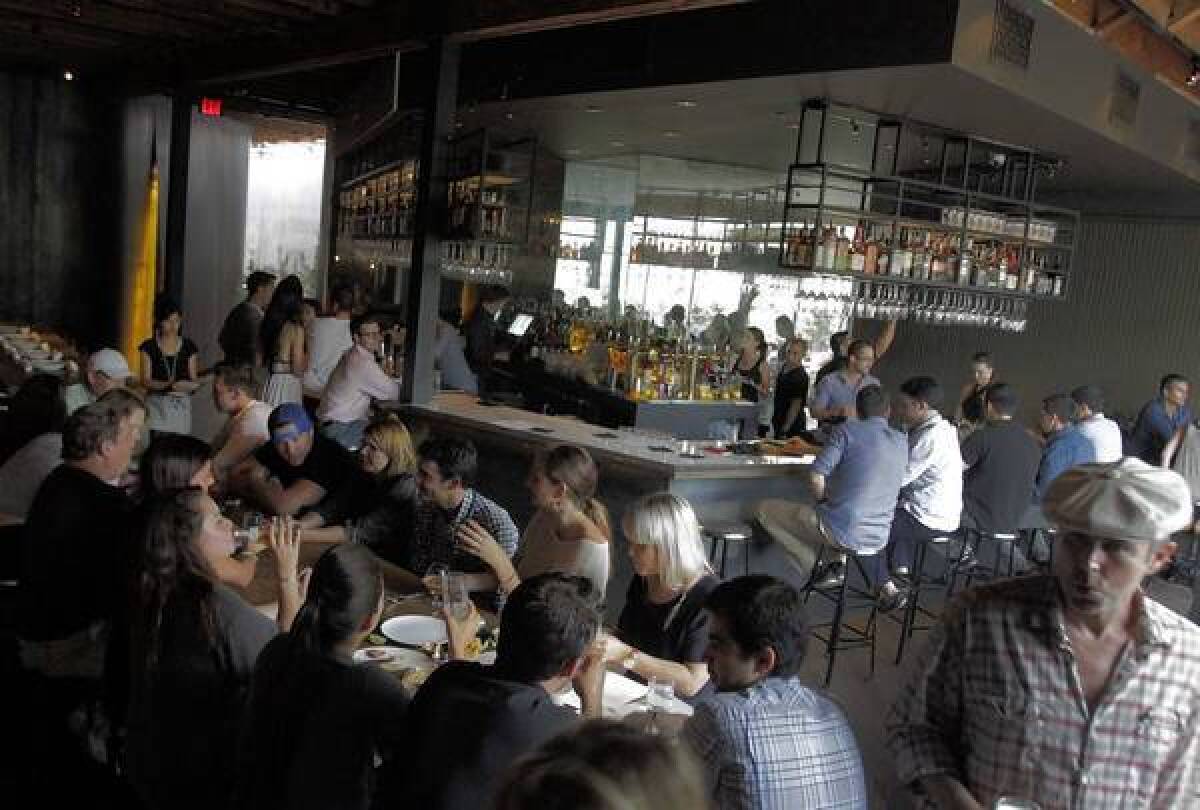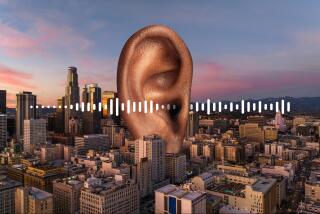Taking a noise snapshot at L.A. restaurants

- Share via
We know it’s noisy out there in the restaurant world. Customers’ complaints are growing, critics are including noise commentary in their reviews, and restaurateurs, to some extent, are trying to figure out ways to modify the acoustic mayhem. But just how noisy is it?
With a decidedly unscientific approach, all it took was a sound meter app (deciBel Pro) and visits to a dozen restaurants and bars across Los Angeles to find out. In many cases, we’re all dining with the noise equivalent of a lawn mower running next to us: That’s 90 decibels. Normal conversation is 60 to 65 decibels. (And the decibel scale, like the Richter scale, is logarithmic: The higher up the decibel scale, the more noise it takes to move the needle.)
Sound meters read sound intensity — the pressure of sound waves traveling through the air from a noise source — not loudness, which is more subjective. A restaurant’s sound intensity level will vary significantly on different days and at different times. But restaurants consistently clocked in at 80 to 90 decibels during peak hours. (Long-term exposure to noise at 80 to 85 decibels can cause hearing damage, experts say.)
Here are some sound level readings at a handful of L.A.’s noisiest restaurants on certain days of the week at particular times. These are sort of noise snapshots, as opposed to average sound levels over a period of time.
THE NOISE CHART
Bottega Louie
Location: Downtown Los Angeles
Time/day: 8 p.m. Sunday
Decibels: 87
The situation: The 10,000-square-foot restaurant has an open, stainless-steel-clad kitchen, soaring 20-foot ceilings, a marble-tiled floor and 20,000 feet of brass millwork. Though sound-absorbing material recently was installed under chairs and banquettes, by 7:30 p.m. on a lazy Sunday the dining room swells with the clanging of dishes and the murmur-on-steroids of hundreds of conversations. By 8 every seat in the house is filled, more than a dozen people are hanging out at the host’s stand and the music (New Order’s “Blue Monday”) is turned up, at which point the decibel meter jumps to 87. But it sounds even louder.
Sound equivalent: Heavy traffic
Laurel Hardware
Location: West Hollywood
Time/day: 8:38 p.m. Saturday
Decibels: 88.3
The situation: Let’s face it: Laurel Hardware might be as much bar as it is restaurant. The music is cranked, and the denizens of WeHo are out for a cocktail-fueled good time. The high-heeled already are swaying, either due to the music or due to a couple of Aqua di Vidas (plum vodka, Champagne and St-Germain). All that noise is bouncing off the floor-to-ceiling windows and the bar’s mirrored and metal-paneled walls. For comparison’s sake: At prime dinner time, it’s as sound-intense in this rustic-chic purveyor of pizzas and small plates as it is at downtown’s Tony’s Saloon at midnight on a Saturday.
Sound equivalent: A whirring blender
Night + Market
Location: Hollywood
Time/day: 6:17 p.m. Sunday
Decibels: 83
The situation: Night + Market is the low-key Sunset Strip restaurant-inside-a-restaurant (a large dining room adjacent to Talesai, to be exact) serving regional Thai street food. On a Sunday just a few minutes before opening, all’s quiet; nobody’s in the restaurant and the music hasn’t been turned on yet (and there’s very little traffic on Sunset). Noise reading? A soothing 55.4 decibels, like a quiet office. But there are tell-tale noise culprits: very tall ceilings, bare tabletops and a concrete floor. It definitely can get echo-y. And sure enough, as soon as the music was turned on and a couple of other tables were seated, the decibel level shot up to 83.
Sound equivalent: An alarm clock 1 foot away
Picca
Location: West Los Angeles
Time/day: 9:08 p.m. Tuesday
Decibels: 90.1
The situation: It’s always crowded at this Westside Peruvian hot spot, where the ceviche is served with plenty of din. The open kitchen, double-high ceilings, chalkboard- and mirror-lined walls, wood floors and tables, loud music (though it’s too noisy to hear what exactly is playing) and bartenders who tend to shake extremely vigorously all help the sound intensity level to breach the 90-decibel hurdle on a Tuesday night. That’s impressive.
Sound equivalent: A power drill
A-Frame
Location: Culver City
Time/day: 8:17 p.m. Wednesday
Decibels: 90.3
The situation: The architecture at Roy Choi’s boisterous A-Frame might provide for some kind of acoustic supernova. There’s the wood-beamed A-frame ceiling of the former IHOP (with speakers affixed to each of the beams), concrete floor and communal wood-and-metal furniture, plus a thumping soundtrack (Santigold, Arcade Fire, ‘80s hip-hop). A-Frame hits the highest reading at 90.3. And as at Picca, nobody seems to mind.
Sound equivalent: A lawn mower
Other common decibel values assigned to some noises:
40 decibels: refrigerator humming
50 decibels: a quiet office
60 decibels: normal conversation at 3 feet
70 decibels: busy traffic or ringing phone
80 decibels: city traffic or vacuum cleaner
90 decibels: factory machinery at 3 feet
100 decibels: subway train or jackhammer
More to Read
Eat your way across L.A.
Get our weekly Tasting Notes newsletter for reviews, news and more.
You may occasionally receive promotional content from the Los Angeles Times.









